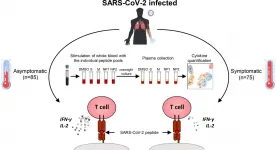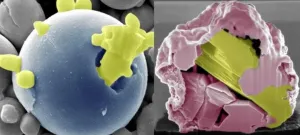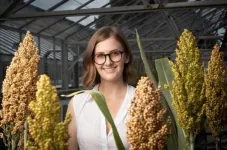(Press-News.org) A joint research team co-led by City University of Hong Kong (CityU) has developed a new soft tactile sensor with skin-comparable characteristics. A robotic gripper with the sensor mounted at the fingertip could accomplish challenging tasks such as stably grasping fragile objects and threading a needle. Their research provided new insight into tactile sensor design and could contribute to various applications in the robotics field, such as smart prosthetics and human-robot interaction.
Dr Shen Yajing, Associate Professor at CityU's Department of Biomedical Engineering (BME) was one of the co-leaders of the study. The findings have been recently published in the scientific journal Science Robotics, titled "Soft magnetic skin for super-resolution tactile sensing with force self-decoupling".
Mimicking human skin characteristics
A main characteristic of human skin is its ability to sense the shear force, meaning the force that makes two objects slip or slide over each other when coming into contact. By sensing the magnitude, direction and the subtle change of shear force, our skin can act as feedback and allow us to adjust how we should hold an object stably with our hands and fingers or how tight we should grasp it.
To mimick this important feature of human skin, Dr Shen and Dr Pan Jia, a collaborator from the University of Hong Kong (HKU), have developed a novel, soft tactile sensor. The sensor is in a multi-layered structure like human skin and includes a flexible and specially magnetised film of about 0.5mm thin as the top layer. When an external force is exerted on it, it can detect the change of the magnetic field due to the film's deformation. More importantly, it can "decouple", or decompose, the external force automatically into two components - normal force (the force applied perpendicularly to the object) and shear force, providing the accurate measurement of these two forces respectively.
"It is important to decouple the external force because each force component has its own influence on the object. And it is necessary to know the accurate value of each force component to analyse or control the stationary or moving state of the object," explained Yan Youcan, PhD student at BME and the first author of the paper.
Deep learning enhanced accuracy
Moreover, the senor possesses another human skin-like characteristic - the tactile "super-resolution" that allows it to locate the stimuli's position as accurate as possible. "We have developed an efficient tactile super-resolution algorithm using deep learning and achieved a 60-fold improvement of the localisation accuracy for contact position, which is the best among super-resolution methods reported so far," said Dr Shen. Such an efficient tactile super-resolution algorithm can help improve the physical resolution of a tactile sensor array with the least number of sensing units, thus reducing the number of wirings and the time required for signal transmitting.
"To the best of our knowledge, this is the first tactile sensor that achieved self-decoupling and super-resolution abilities simultaneously," he added.
Robotic hand with the new sensor completes challenging tasks
By mounting the sensor at the fingertip of a robotic gripper, the team showed that robots can accomplish challenging tasks. For example, the robotic gripper stably grasped fragile objects like an egg while an external force trying to drag it away, or threaded a needle via teleoperation. "The super-resolution of our sensor helps the robotic hand to adjust the contact position when it grasps an object. And the robotic arm can adjust force magnitude based on the force decoupling ability of the tactile sensor," explained Dr Shen.
He added that the sensor can be easily extended to the form of sensor arrays or even continuous electronic skin that covers the whole body of the robot in the future. The sensitivity and measurement range of the sensor can be adjusted by changing the magnetisation direction of the top layer (magnetic film) of the sensor without changing the sensor's thickness. This enabled the e-skin to have different sensitivity and measurement range in different parts, just like human skin.
Also, the sensor has a much shorter fabrication and calibration processes compared with other tactile sensors, facilitating the actual applications.
"This proposed sensor could be beneficial to various applications in the robotics field, such as adaptive grasping, dextrous manipulation, texture recognition, smart prosthetics and human-robot interaction. The advancement of soft artificial tactile sensors with skin-comparable characteristics can make domestic robots become part of our daily life," concluded Dr Shen.
INFORMATION:
Dr Shen and Dr Pan are the corresponding authors of the paper. CityU team members include PhD students Yan Youcan and Hu Zhe from BME and Dr Yang Zhengbao, Assistant Professor from the Department of Mechanical Engineering. Other collaborating researchers are from Carnegie Mellon University and the Southern University of Science and Technology.
The research was funded by the National Natural Science Foundation of China, Hong Kong Research Grant Council and Shenzhen (China) Key Basic Research Project.
https://www.cityu.edu.hk/research/stories/2021/03/01/novel-soft-tactile-sensor-skin-comparable-characteristics-robots
By analyzing blood samples from individuals infected with SARS-CoV-2, researchers in Singapore have begun to unpack the different responses by the body's T cells that determine whether or not an individual develops COVID-19. The study, published today in the Journal of Experimental Medicine (JEM), suggests that clearing the virus without developing symptoms requires T cells to mount an efficient immune response that produces a careful balance of pro- and anti-inflammatory molecules.
Many people infected with the SARS-CoV-2 virus do not develop any symptoms, and the infection ...
UNIVERSITY PARK, Pa. -- The rate of suicide among post-9/11 military veterans has been rising for nearly a decade. While there are a number of factors associated with suicide, veterans have unique experiences that may contribute to them thinking about killing themselves.
"Compared to their civilian peers, veterans are more likely to report having experienced traumatic adverse childhood experiences (ACEs) such as physical and emotional abuse," stated Keith Aronson, associate director of the Clearinghouse for Military Family Readiness at Penn State and the Social Science Research Institute ...
LAWRENCE -- A new study from University of Kansas journalism & mass communication researchers examines what influences people to be susceptible to false information about health and argues big tech companies have a responsibility to help prevent the spread of misleading and dangerous information.
Researchers shared a fake news story with more than 750 participants that claimed a deficiency of vitamin B17 could cause cancer. Researchers then measured if how the article was presented -- including author credentials, writing style and whether the article was labeled as "suspicious" or "unverified" -- affected how participants perceived its credibility and whether they would adhere to the article's recommendations or share it on social media. The findings showed that ...
AMES, Iowa - Inspired by nature's work to build spiky structures in caves, engineers at Iowa State University have developed technology capable of recovering pure and precious metals from the alloys in our old phones and other electrical waste.
Using controlled applications of oxygen and relatively low temperatures, the engineers say they can dealloy a metal by slowly moving the most reactive components to the surface where they form stalagmite-like spikes of metal oxides.
That leaves the least-reactive components in a purified, liquid core surrounded by brittle metal-oxide spikes "to create a so-called 'ship-in-a-bottle structure,'" said Martin Thuo, the leader of the research project and an associate professor of materials science and ...
A type of ultrasound scan can detect cancer tissue left behind after a brain tumour is removed more sensitively than surgeons, and could improve the outcome from operations, a new study suggests.
The new ultrasound technique, called shear wave elastography, could be used during brain surgery to detect residual cancerous tissue, allowing surgeons to remove as much as possible.
Researchers believe that the new type of scan, which is much faster to carry out and more affordable than 'gold standard' MRI scans, has the potential to reduce a patient's risk of relapse by cutting the chances that a tumour will grow ...
The amount of green space surrounding children's homes could be important for their risk of developing ADHD. This is shown by new research results from iPSYCH.
A team of researchers from Aarhus University has studied how green space around the residence affects the risk of children and adolescents being diagnosed with ADHD. And the researchers find an association.
"Our findings show that children who have been exposed to less green surroundings in their residential area in early childhood, which we define as lasting up until age five, have an increased risk of receiving an ADHD diagnosis when compared to children who have been surrounded by the highest level of green space," says ...
Anorexia nervosa, bulimia nervosa and binge-eating disorder are the three main eating disorders that 4 out of in 10 individuals living in Western Europe will experience at some point in their lives. In recent years, studies on the genetic basis of anorexia nervosa have highlighted the existence of predisposing genetic markers, which are shared with other psychiatric disorders. By analysing the genome of tens of thousands of British people, a team from the University of Geneva (UNIGE), the University Hospitals of Geneva (HUG), King's College London, the University College London, the University of North Carolina (UNC) and The Icahn ...
Research from the University of Kent has led to the development of the MeshCODE theory, a revolutionary new theory for understanding brain and memory function. This discovery may be the beginning of a new understanding of brain function and in treating brain diseases such as Alzheimer's.
In a paper published by Frontiers in Molecular Neuroscience, Dr Ben Goult from Kent's School of Biosciences describes how his new theory views the brain as an organic supercomputer running a complex binary code with neuronal cells working as a mechanical computer. He explains ...
Gene editing technology will play a vital role in climate-proofing future crops to protect global food supplies, according to scientists at The University of Queensland.
Biotechnologist Dr Karen Massel from UQ's Centre for Crop Science has published a review of gene editing technologies such as CRISPR-Cas9 to safeguard food security in farming systems under stress from extreme and variable climate conditions.
"Farmers have been manipulating the DNA of plants using conventional breeding technologies for millennia, and now with new gene-editing technologies, we can do this with unprecedented safety, precision and speed," Dr Massel said.
"This type of gene editing mimics the way cells repair in nature."
Her review recommended ...
New research from the University of Kent reveals social cohesion with immigration is best ensured through childhood exposure to diversity in local neighbourhoods, leading to acceptance of other groups.
The research, which is published in Oxford Economic Papers, builds on the Nobel Laureate economist Thomas Schelling's Model of Segregation, which showed that a slight preference by individuals and families towards their own groups can eventually result in complete segregation of communities.
Shedding new light on this issue, researchers from Kent's School of Economics have introduced the theory ...


